Chapter
Five Part Five
|
Now back to 1928 and
Sunbeam, who of course were also experiencing difficulties. The
same range of cars, little changed from the previous year were
offered, and when road tested they still received praise from
journalists.
On the competition side
the Wolverhampton cars gained numerous successes in record
breaking runs with Kaye Don being a star performer. Local man
E.L. Bouts also had a number of successes at Brooklands. The
name Bouts is of course well known to this day in the
Wolverhampton motor trade for the family still operate a
thriving motor agency and garage. If we are to report great
international successes we must once again turn to the
Wolverhampton motorcycle concerns. Despite the fact that they
were suffering trading difficulties, both A.J.S. and Sunbeam
continued to support a full competition programme. |
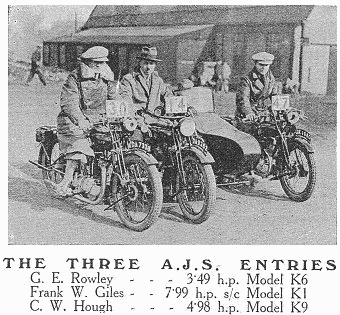 |
As noted above A.J.S.
reverted to push rod operated valves for 1928, but
they would still have troubles in the T.T. races.
The Junior proved to be a
disaster. The race was dominated by Velocettes and
Alec Bennett won at an average speed of 68.65m.p.h.
with team mate Harold Willis second. Bennett
also set a record lap at 70.28m.p.h. There had been
six A.J.S. machines in the race, but all had retired
as had the five Sunbeams.
Despite this very poor showing
in the Junior race, most people expected much better
things in the Senior. |
| Practice runs had shown the
A.J.S. machines to be very fast and with Jimmy
Simpson and George Rowley among their riders a good
performance could be expected. The team’s newcomer
Tommy Spann could also be looked to for a good
performance. He had left Sunbeam after marrying one
of George Stevens' daughters and so would be out to
do well. Sunbeam also had a very talented team
including Charlie Dodson, Italian Luigi Arcangeli
and Swiss ace Francisco Franconi. The Wolverhampton
teams could expect strong opposition from the very
formidable Rudge team, helped by their late
competition manager Graham Walker, together with
H.G. Tyrell Smith and Ernie Nott. Added to this was
the Norton team with Stanley Woods and Alec Bennett
and the Scotts of Harry Langman and the Langton
brothers, Eric and Oliver. It could be seen that
with such men and machines the race of the century
was in the offing.
Unfortunately the Clerk of the
Weather ruled otherwise, sending really atrocious
weather, the wettest T.T. to date. Despite the truly
terrible weather conditions Jimmy Simpson was off
like a scalded cat to lead for the first two laps
making what would prove to be the day’s fastest
circuit in 32 minutes 20 seconds, an average speed
of 67.94m.p.h. On lap 3 Simpson retired with engine
trouble and Charlie Dodson went into the lead.
Graham Walker in 2nd spot now gave the Rudge its
head and in lap 6 got ahead of the Sunbeam with an
advantage of 3 minutes. It looked all set for Rudge
to win their first T.T. since 1914, but it was not
to be. With just 13 miles to the chequered flag
Walker was sidelined with mechanical trouble, which
put Dodson into an unassailable lead. He went on to
win his first T.T. by over 8 minutes from second man
George Rowley on his A.J.S. This was George's best
ever T.T. result. |
|
Dodson's time for the 7
laps had been 4 hours 11 minutes 40 seconds, an average speed of
62.98m.p.h. This gives some indication of the prevailing
conditions as it was the slowest Senior since 1924. None the
less a very fine performance by Dodson as was Simpson's fastest
lap.
Other
Sunbeam placings were Franconi 7th, Arcangeli 15th
and Simcock 19th. This gained Sunbeam the
manufacturer’s team prize for the 2nd year in
succession. New AJ man Tommy Spann finished 13th so
it had turned out to be quite a good Senior for the
Wolverhampton contingent.
There had
been one HRD in the race, no doubt made at the
Wolverhampton factory before its closure, however it
had to retire during the race.
|
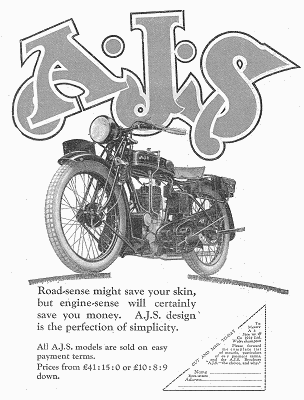 |
|
Before considering the
1928 Amateur T.T. we shall look at that year’s Ulster Grand
Prix. There were 78 competitors, 30 riding 500c.c. machines, 21
on 3500c.c. machines, l6 on 250s and 5 others. The last two
classes will not concern us here as no Wolverhampton machines
were included. In the 500c.c. class there was a thrilling duel
between Graham Walker riding a Rudge and Charlie Dodson aboard a
Sunbeam. The battle lasted throughout the race with first one
then the other in the lead. The titanic struggle ended in
Walker's favour by 11 seconds at an average speed of
80.08m.p.h., the first over 80m.p.h. The fastest lap fell to
Charlie Dodson who went round. in 15 minutes 3 seconds, an
81.72m.p.h. record.
The 350c.c.
also turned out to be a needle match between Jimmy
Guthrie on a Norton, Frank Longman on a Velocette
and Leo Davenport on an A.J.S. The first part of the
race saw a ding dong struggle between the trio, but
then the AJ slowed and Guthrie retired. Longman took
the Velocette through to win by a little over four
minutes from Davenport's AJ. Jimmy Shaw came in
third on a Norton. The winner’s time was 2 hours
45minutes 32 seconds, an average speed of
74.31m.p.h. A 350c.c. record. |
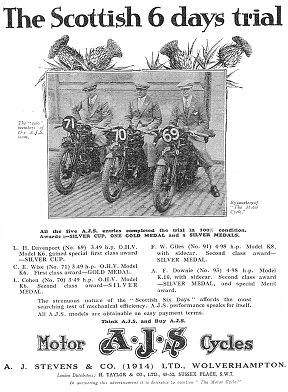 |
Now back to the Isle of
Man. As envisaged, 1928 would see two races in September, a
Senior and a Junior Amateur T.T. The later took place on Tuesday
4th with the 500s racing on Thursday. This was a very
popular move with the competitors, now any rider so wishing
could ride in both races and spectators would get two days
racing. Entries for the first “Junior” Amateur T.T. were 26 and
included 13 different makes of machine. Amongst these were 5
Sunbeams, 3 A.J.S. and a single HRD.
Practice
form had shown Tim Hunt to be a very strong
contender, though the know-alls did not think
he could do it. They agreed Hunt was a fine rider,
perhaps the best Amateur to date, but his machine a
350c.c. ohv Levis was an unknown quantity. Levis
were of course famous for their two strokes and had
been very successful with them in races, but four
strokes and overhead valves were new to them so all
in all not too much could be expected. |
| Good weather attended the
race and Hunt took an early lead to have an
advantage of 1.5 minutes over J. Hanson on his
Velocette and Gilbert Emery on a Sunbeam at the end
of lap one. On the following lap W.H.T Meageen
really opened up his Rex Acme to take second place.
Hunt also speeded up and held on to his lead. On lap
5 Meageen really dug his spurs in to go round in 35
minutes 20seconds, an average speed of 64.08m.p.h.,
which proved to be the day’s fastest and an Amateur
T.T. record. |
| None the less Hunt maintained
his lead until the final lap when with just three
miles to go the Levis engine gave out. What terrible
luck for Tim Hunt and Levis.
W.H.T. Meageen went on to win
and became the first Manxman to win an Amateur T.T.
He did it at a record speed of 6l.58m.p.h. and as
noted above made a record lap. J. Hanson finished
2nd on his Velocette, 3 minutes 43 seconds in
arrears and another Velo claimed 3rd spot with Dick
Birch in 4th place on his Sunbeam.
S. Lees on another Sunbeam
came home 9th followed by the only HRD in the race.
All the A.J.S. riders retired. |
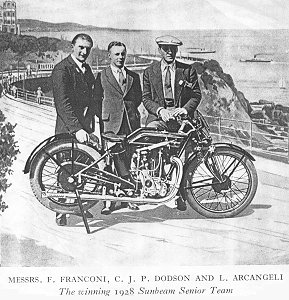 |
|
Everyone now looked forward to a fast and
exciting Senior T.T. Very fast times had been set in practice
and race day would enjoy near perfect weather conditions. Tim
Hunt, now aboard a Norton could be expected to avenge his Junior
race disappointment and though the Junior winner Meageen would
be riding the same machine, he too could be expected to put up a
strong fight. The experts very much favoured a win for a Sunbeam
rider, for both Dick Birch and Gilbert Emery were most competent
riders. They had been very fast in practice and their
Wolverhampton made machines were superb. |
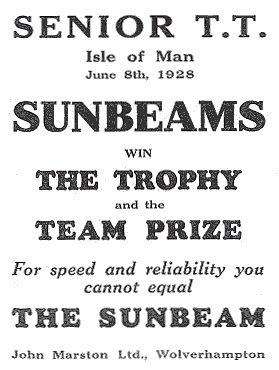 |
The 1928 Senior Manx Amateur T.T. got
off to a cracking start with Birch and Emery dead heating
for the lead at the end of the first lap. They went round in
33 minutes 33 seconds, a record, and from a standing start.
As expected a fast race was in prospect. On the 2nd round
Birch took the lead and pulled out a 13 second advantage and
Hunt, who had been suffering some problems with the Norton
had fallen back, though he still held 3rd spot behind the
Sunbeams.
On lap 4 Tim Hunt found his form,
pulled out all the stops and took a 2 second lead over
Birch. Hunt’s final lap was covered in 31minutes 10seconds,
an average speed of 71.0lm.p.h. This was a record and the
fastest the Isle of Man mountain circuit had been covered to
date. The winner’s race time of 3 hours l9 minutes 58seconds
also constituted a record at 67.94m.p.h. 2nd place fell to
Dick Birch who finished 3 minutes l0 seconds behind Hunt.
|
| Gilbert Emery took 3rd spot whilst
the riders of 4 other Sunbeams and of 3 A.J.S. machines
retired during the race. Around
this time a new motor sport came to England, called speedway
or dirt track racing. This type of racing had been popular
in the United States and in Australia for some years. A
number of British enthusiasts had seen it down under and
thought it could become a popular sport at home, and so
indeed it would. After the war speedway became Britain's
second most popular sport after soccer. None the less let it
be noted that the BBC refused to broadcast speedway results.
At first dirt track racing was indulged in by almost anyone,
and many types of machines were used. After a few years
things began to get more specialised, and many manufacturers
listed a ‘dirt’ model amongst their ranges. The
specifications for such machines were varied and included
flat twins, ‘V’ twins, ohv and camshaft models. A.J.S. were
fairly early in the field and produced a very fast overhead
camshaft machine and they enjoyed some success in the hands
of riders like Billy Lamont, Frank Arthur and Cecil Brown.
Sunbeam were a bit late in entering this market, not listing
a 'dirt' model until 1930. It was exhibited at that year’s
motorcycle show. |
|
As would be expected of
a Marston product the Sunbeam speedway machine was beautifully
made and finished. In effect it was a Model 90 with single port
head, and apart from a lowered frame and small fuel tank it was
in fact a standard road racing model. Forks of T.T. pattern did
not make for a good 'dirt' bike and there were few buyers at the
asking price of £90. Well known local rider Tommy Deadman rode
one of the Sunbeam prototypes in a few races and had a very
hectic time of it. Leg trailing was at that time universal and
Tommy found the machine near unmanageable, so he tried leg
forward, but with 1ittle better result. It could well be that
Tommy Deadman was the first speedway rider to try the leg
forward style of riding.
After protests from the
few riders who had them, the Sunbeam was modified to have
speedway type forks, but it was all to late for by now the JAP
motor had come on the scene and speedway machines would become
very specialised and all would look alike. Just before leaving
the 'dirt' we can note that this sport started quite early at
Monmore Green and despite ups and downs continues to the present
day. |
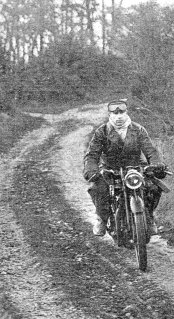
Dodson and his Sunbeam. |
| We have met, and shall meet again
Aussie 'Digger' Simcock who raced successfully on Sunbeams,
but later also had connections with the town, for in the
1950s he was manager of Wolverhampton Speedway.
There was little change in the Sunbeam Motor Company's range
of cars for 1929, however some interesting projects were
under development. Experiments were being made with diesel
engines for aeroplane use, a commercial vehicle chassis and
a new contender for the world land speed record was under
development.
Way back around 1910
Hugh Rose had started work at Sunbeam and when Sidney Guy
left in 1914 to form his own company, Rose left with him and
moved to Fallings Park. He returned to Sunbeam in the late
1920s to design commercial vehicles and to be in charge of
the new record attempt car.
During 1929 two Sunbeam
commercial vehicles were announced, both intended for passenger
work. They were the two axle “Pathan” and the three axle “Sikh”.
Both shared the same eight litre six cylinder ohv petrol engine
which developed l42b.h.p. They were fast vehicles and it is said
the prototypes were tested by collecting fish at Grimsby. Only a
handful were built and all were fitted with single deck coach or
bus bodywork. Sunbeam commercial vehicle production soon ceased,
but as we shall see the name would become well known for trolley
buses later on. |
|

Whilst Sunbeam were
trying to break into the commercial field A.J.S. were also
developing similar vehicles at their Lower Walsall Street
factory. They were launched in 1929 and “Commercial Motor”
magazine gave a quite comprehensive write up of the new
A.J.S. chassis. Two models were produced, the “Pilot” and
the “Commodore”. |
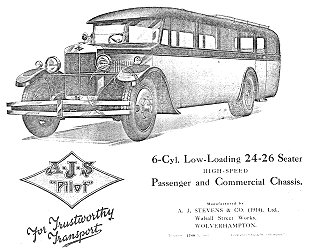 |
They were mainly intended for
passenger work though some lorries and vans were produced.
Both had Coventry Climax six cylinder ohv petrol engines.
The “Pilot” developed 70b.h.p. and the “Commodore” 100b.h.p.
The former could be had in normal or forward control
versions and the chassis price was £685 and £705
respectively. The “Commodore” was only listed as forward
control and cost £850. Like the Sunbeams these vehicles were
fast for their day and with a load of two tons could exceed
55m.p.h. and would cruise quite happily at 45m.p.h. |
| In their report “Commercial Motor”
said, “Wolverhampton bids fair to become in the near future
a very important commercial vehicle manufacturing centre.”
Well one cannot doubt that this was so with regard to Guy
Motors, but the writing was on the wall for A.J.S. and
Sunbeam and very few of either concerns commercial vehicles
were built. |
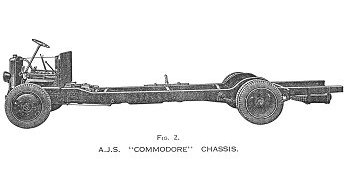 |
| It was during 1929 that the Briton
car ceased production. Charles Weight rescued the marque in
1922 and since then something like 1,000 Britons had been
produced. The firm now became Tractor Spares and yet another
fine motor car passed into history. Also during 1929 the
Star Frederick Street works were closed down, though in this
case of course production continued at the new Bushbury
Works. Though considerably smaller it was hoped to expand,
as something like 20 acres were available. In the event
however some land had to be sold off to raise capital and
only about 250 men were employed at the works. Even so some
were still being laid off for weeks at a time and it is said
that at this time Dick Lisle worked as manager of the
hardening department but soon left and moved away from
Wolverhampton. |
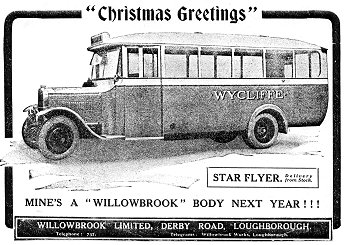 |
Production of Stars for
1929 would be around 294 cars of which all but 45 were 18/50s.
This popular model had a 69 x 100mm ohv six cylinder engine and
with saloon bodywork cost £575, whilst the five seater tourer
sold for £495.
Commercial vehicle
production would total 157 including a low loading coach
chassis with 80 x l20mm ohv six cylinder engine, listed at
£645. It conformed to Scotland Yard’s regulations to carry
26 passenger bodywork. |
|
Guy offered a similar
range of vehicles at a slightly high price and they were now
contemplating ending Star commercial vehicle production. As is
the case with takeovers, many of the old Star hands were not
happy to come under Guy. Several people in managerial positions
left as did a number of workmen, some of their own accord but
others were dismissed.
Changes were also taking
place at Sunbeamland for during 1928 it had been part of the
newly formed ICI (Imperial Chemical Industries) group. The
changes however were by no means drastic and motorcycles of a
very high quality continued to be produced. Some purists were
upset when for 1929 saddle tanks were introduced. Whilst perhaps
a motorcycle so fitted was not as handsome as one with a flat
tank, fashion demanded saddle tanks and fashion had to be
followed if you wished to stay in business. The racing programme
continued as before and Sunbeam notched up some notable
successes. |
 |
 |
 |
Return to
Part 4 |
Return to
the beginning |
Proceed to
Part 6 |
|